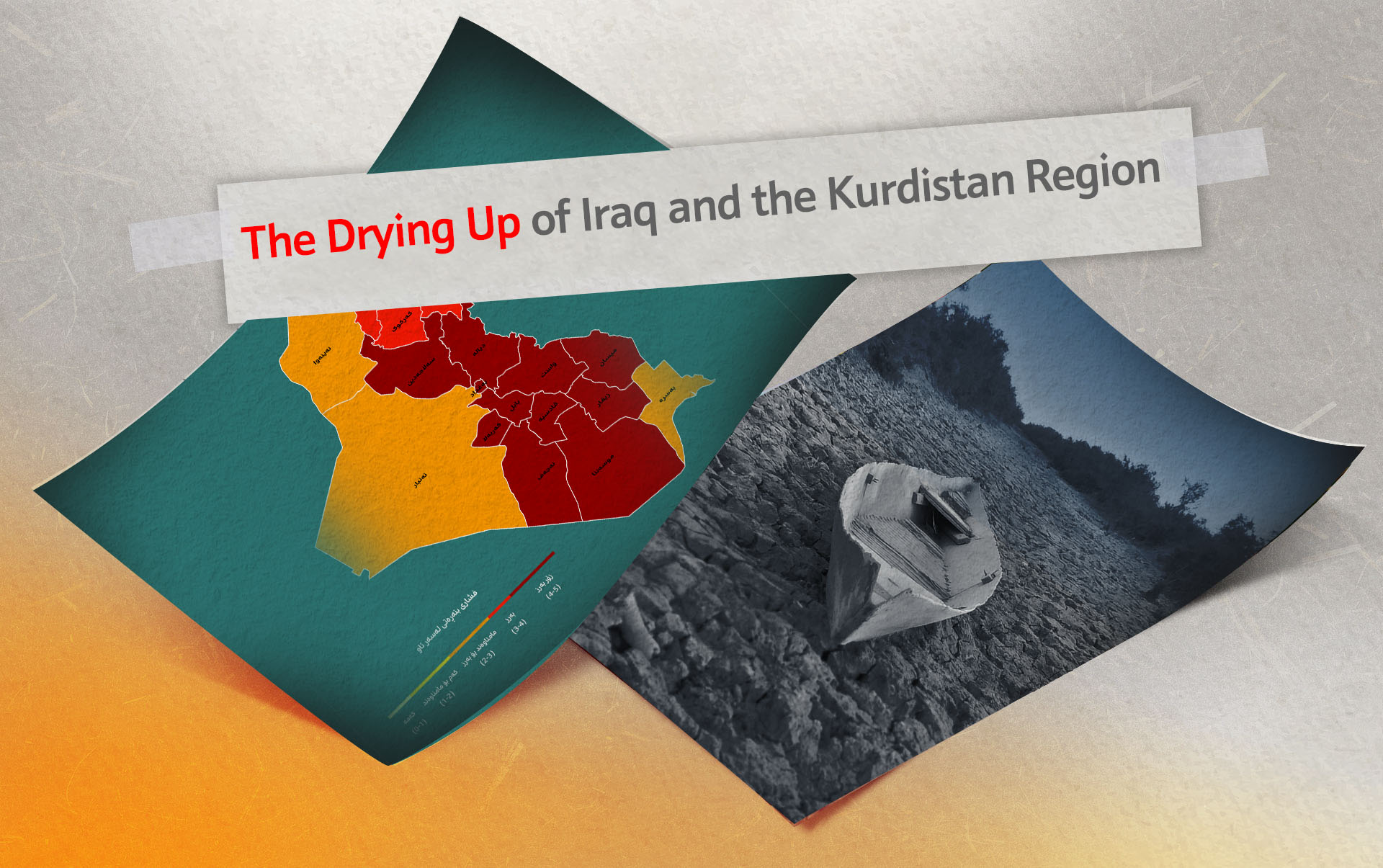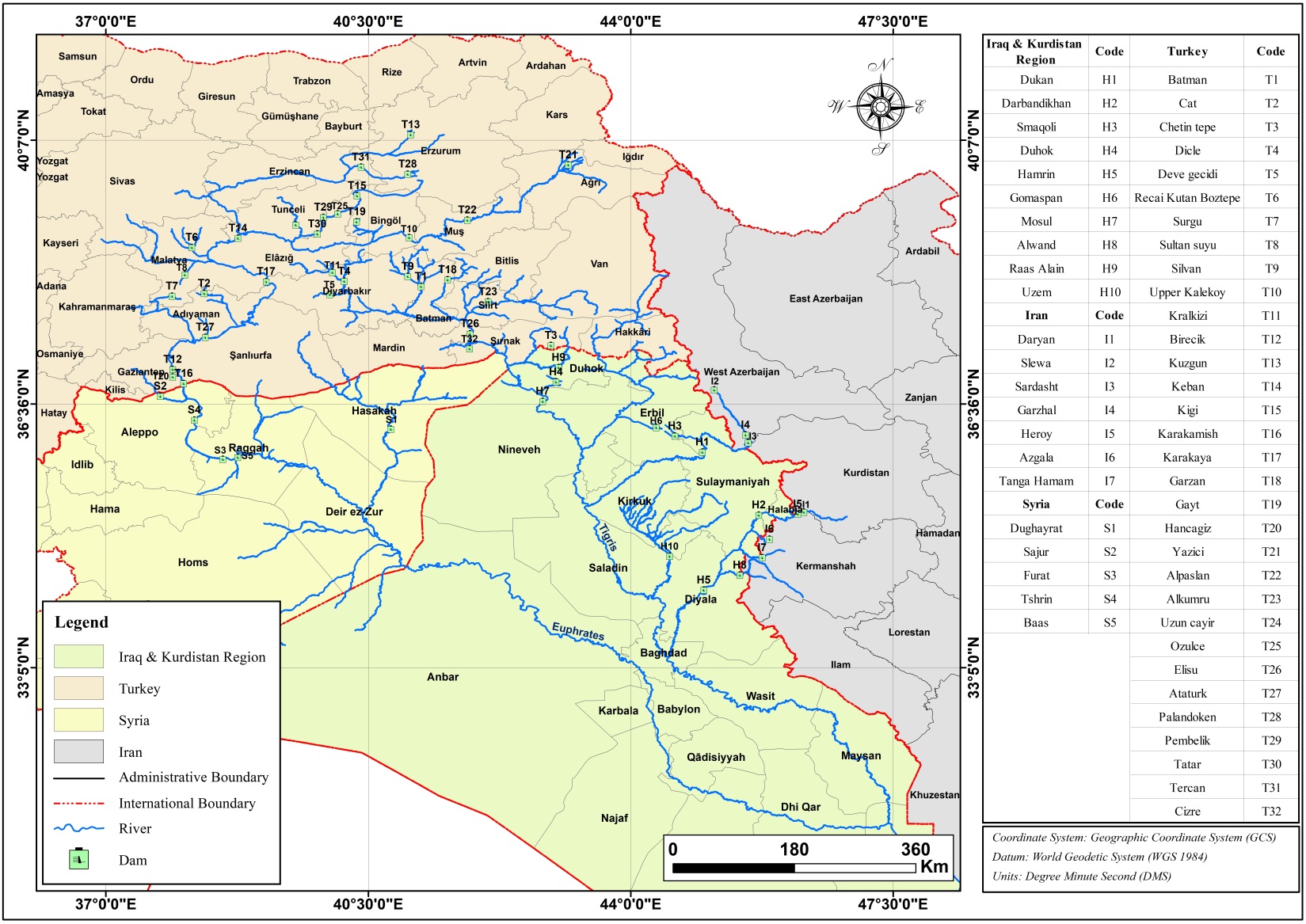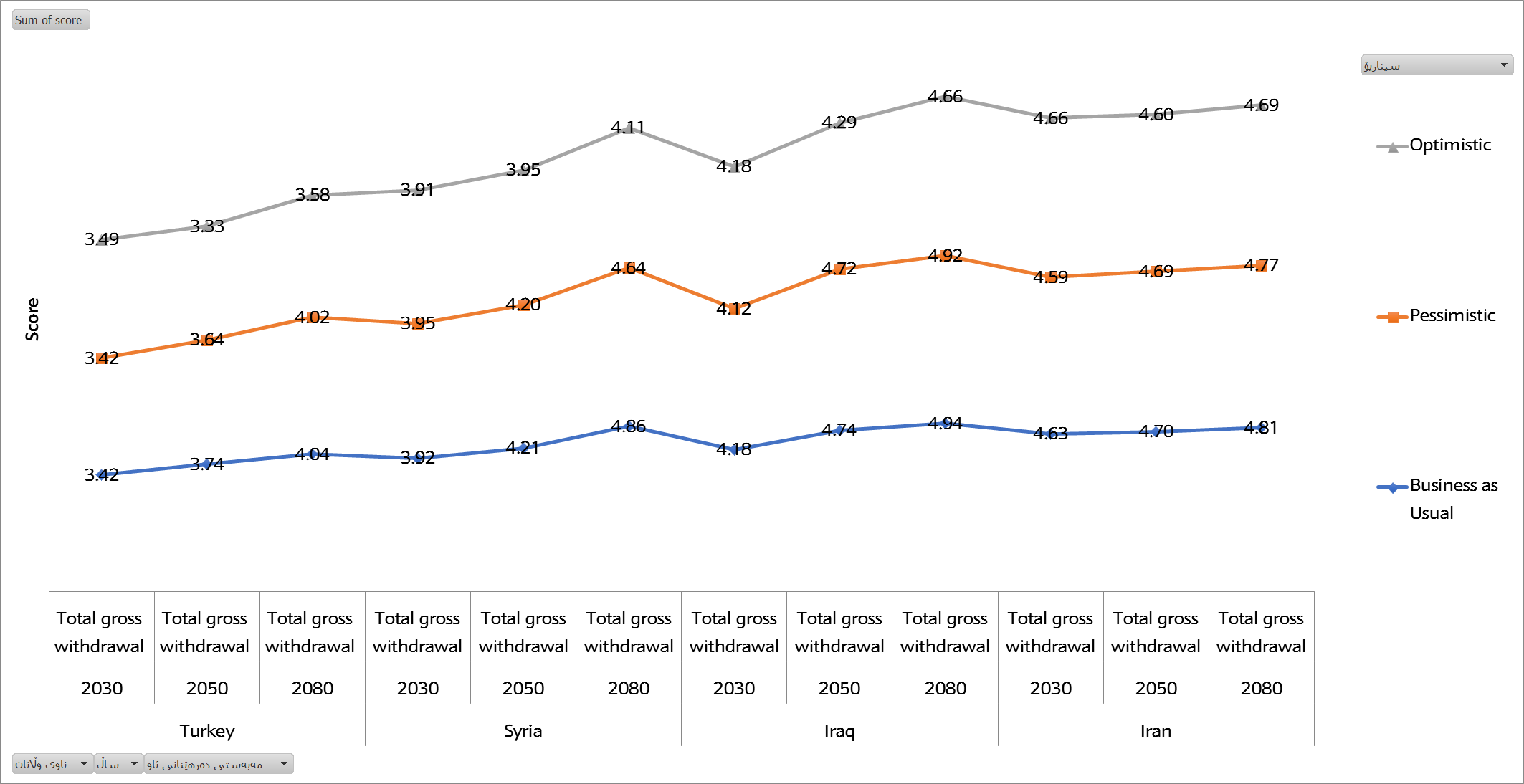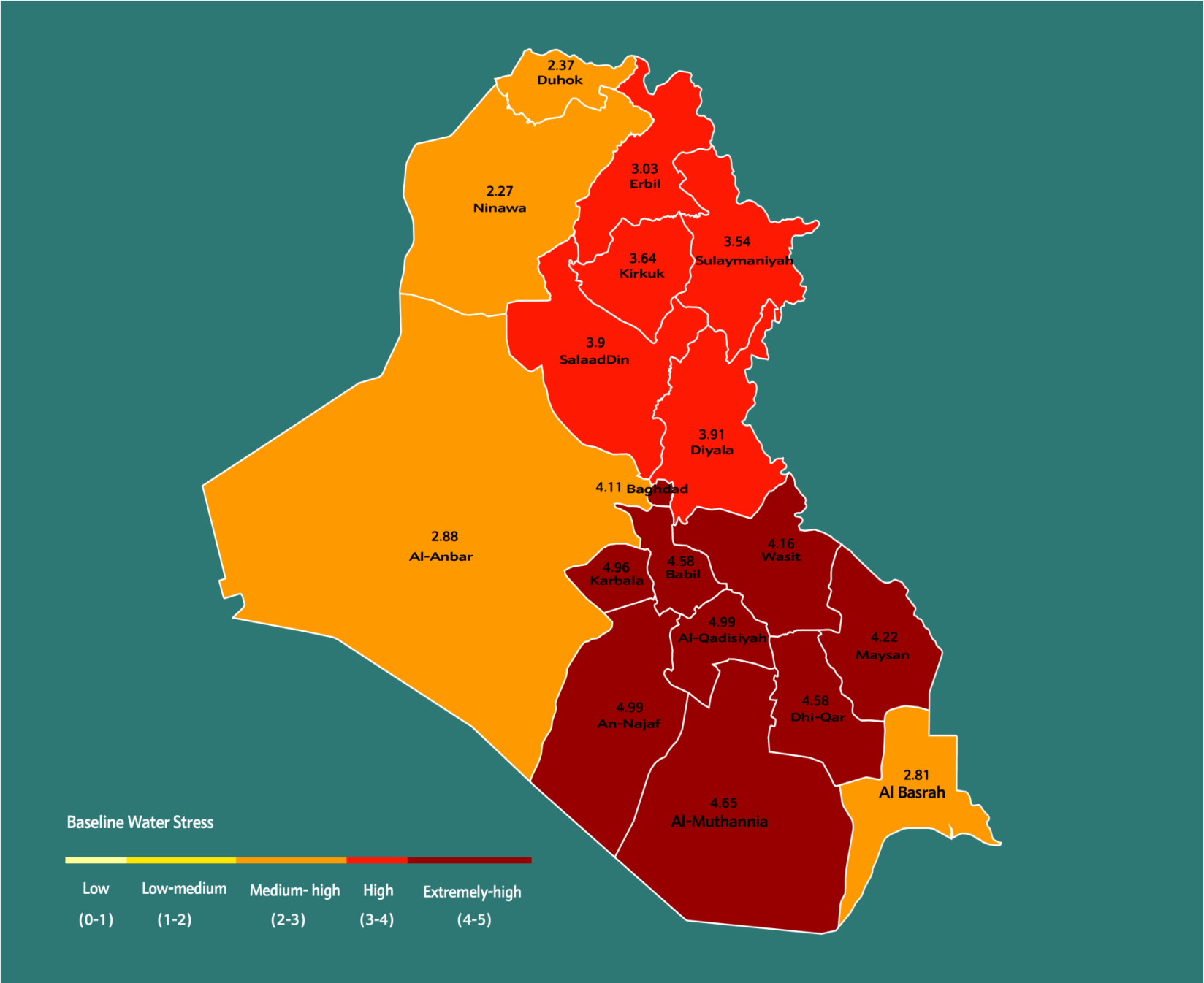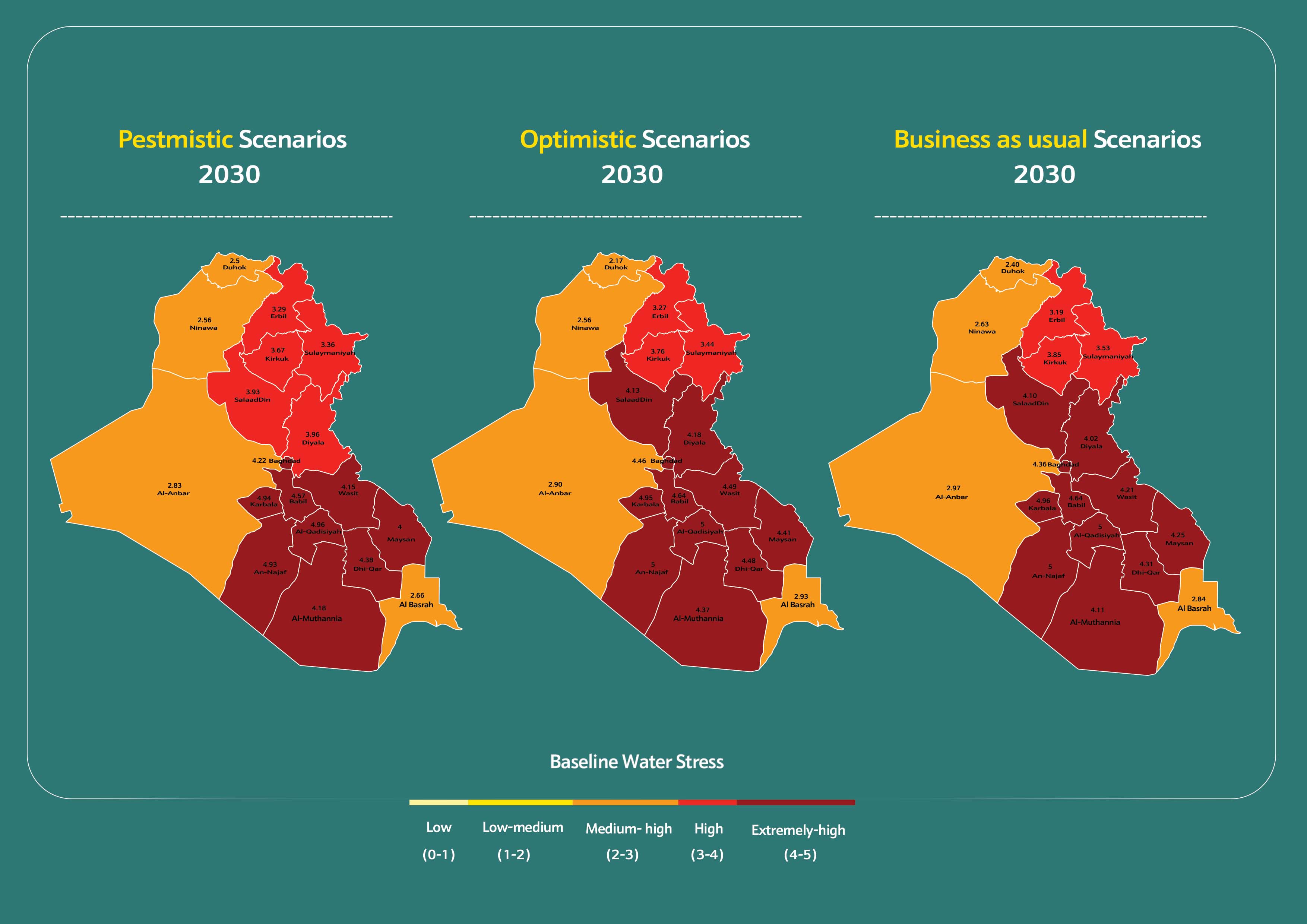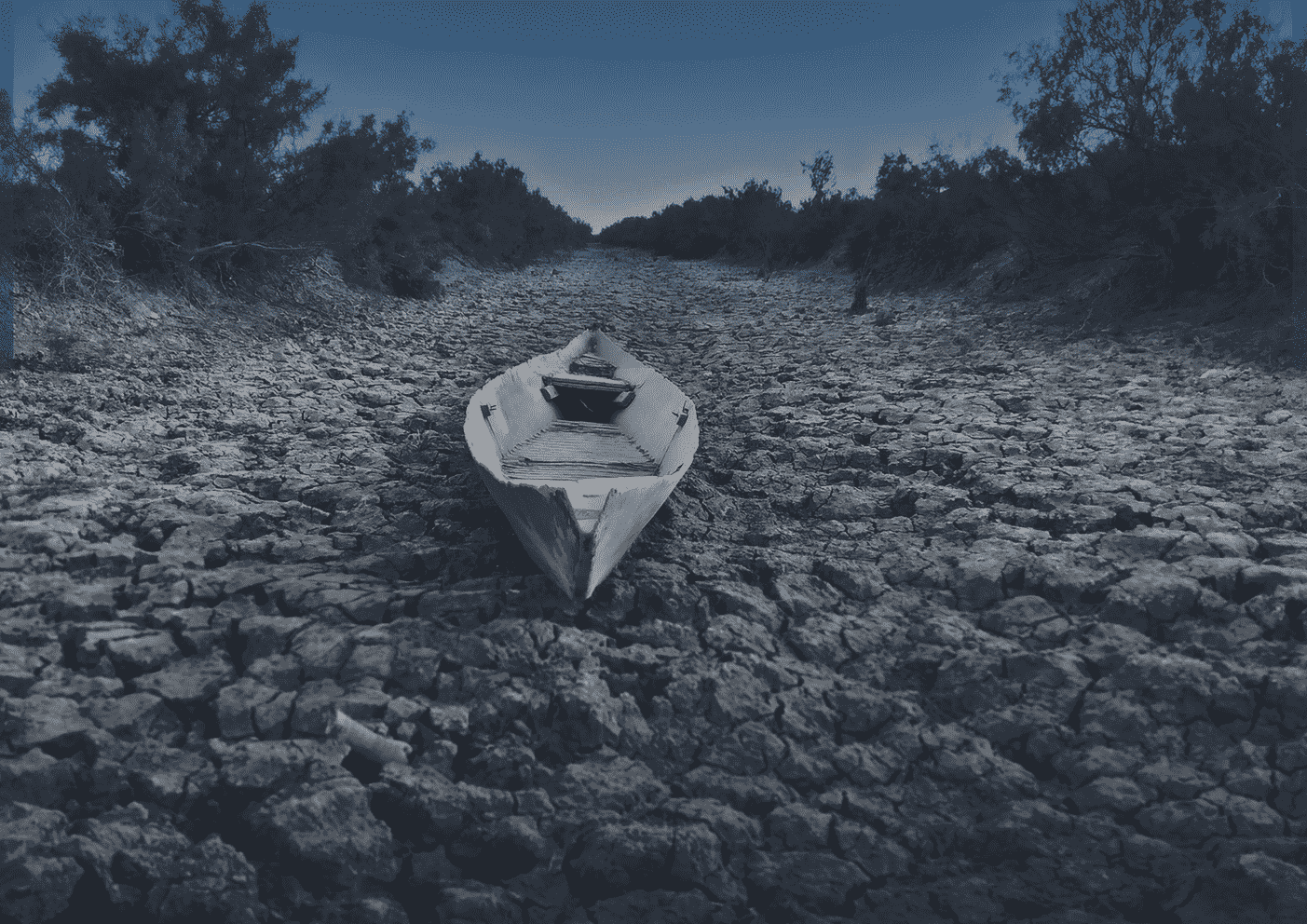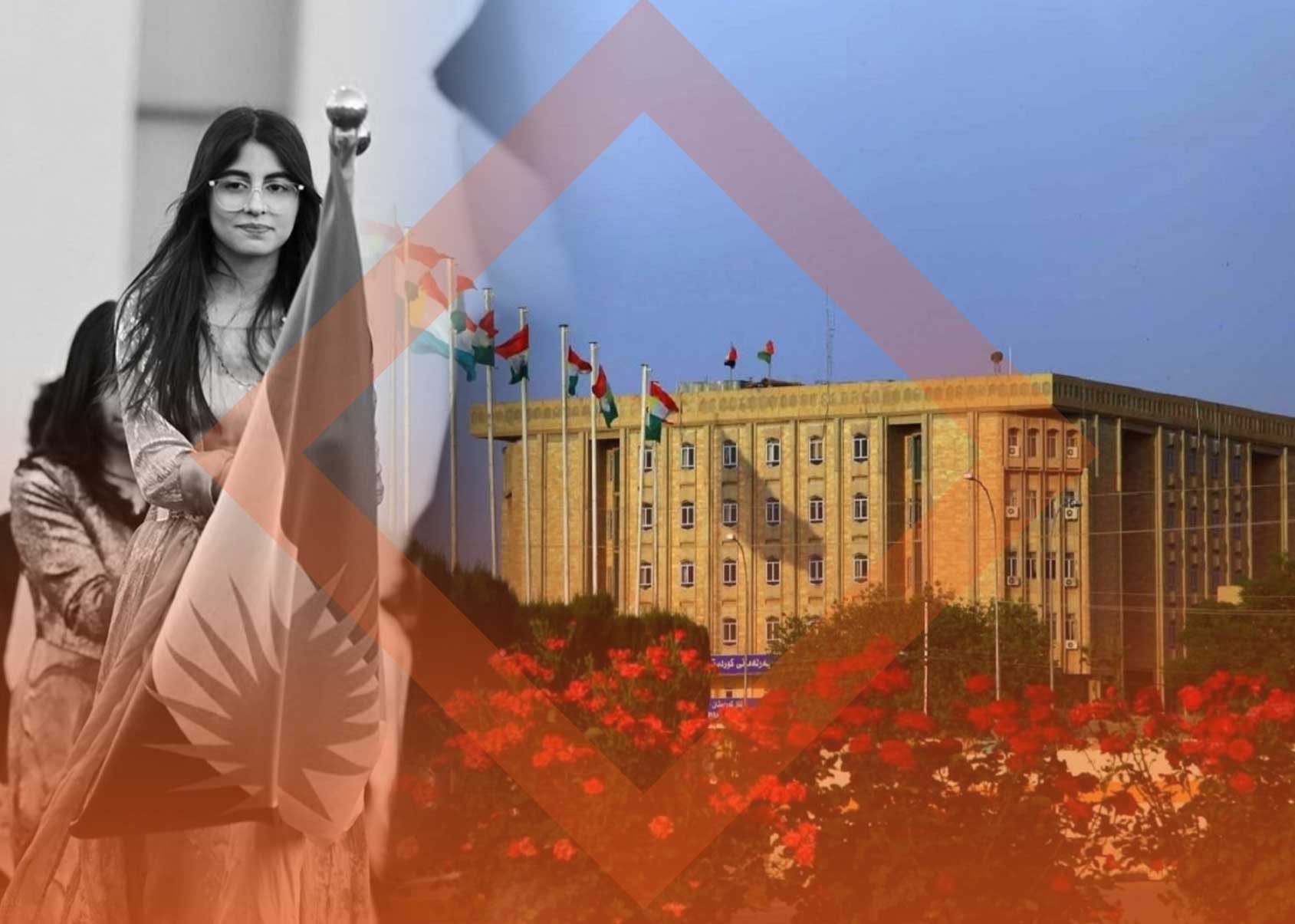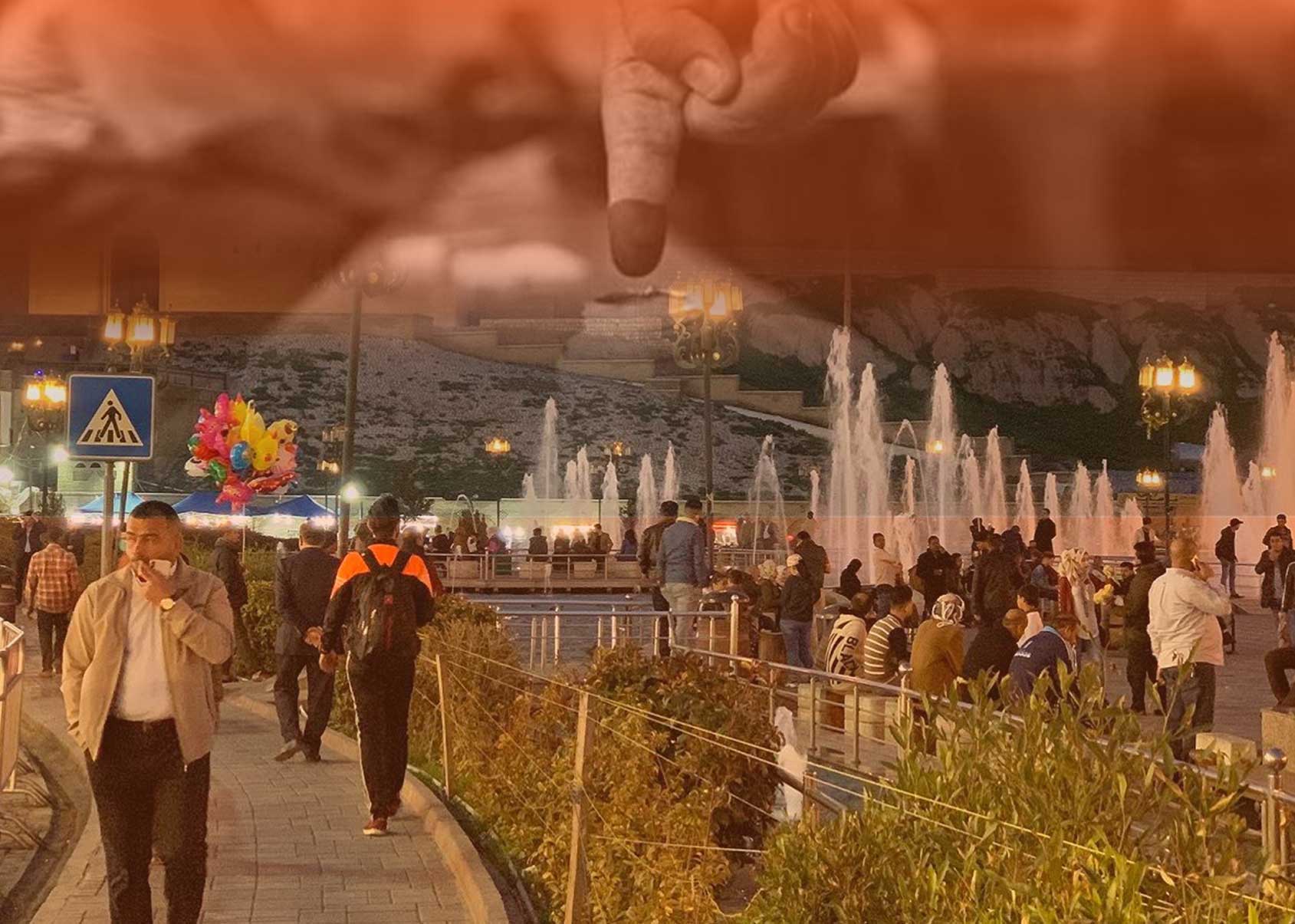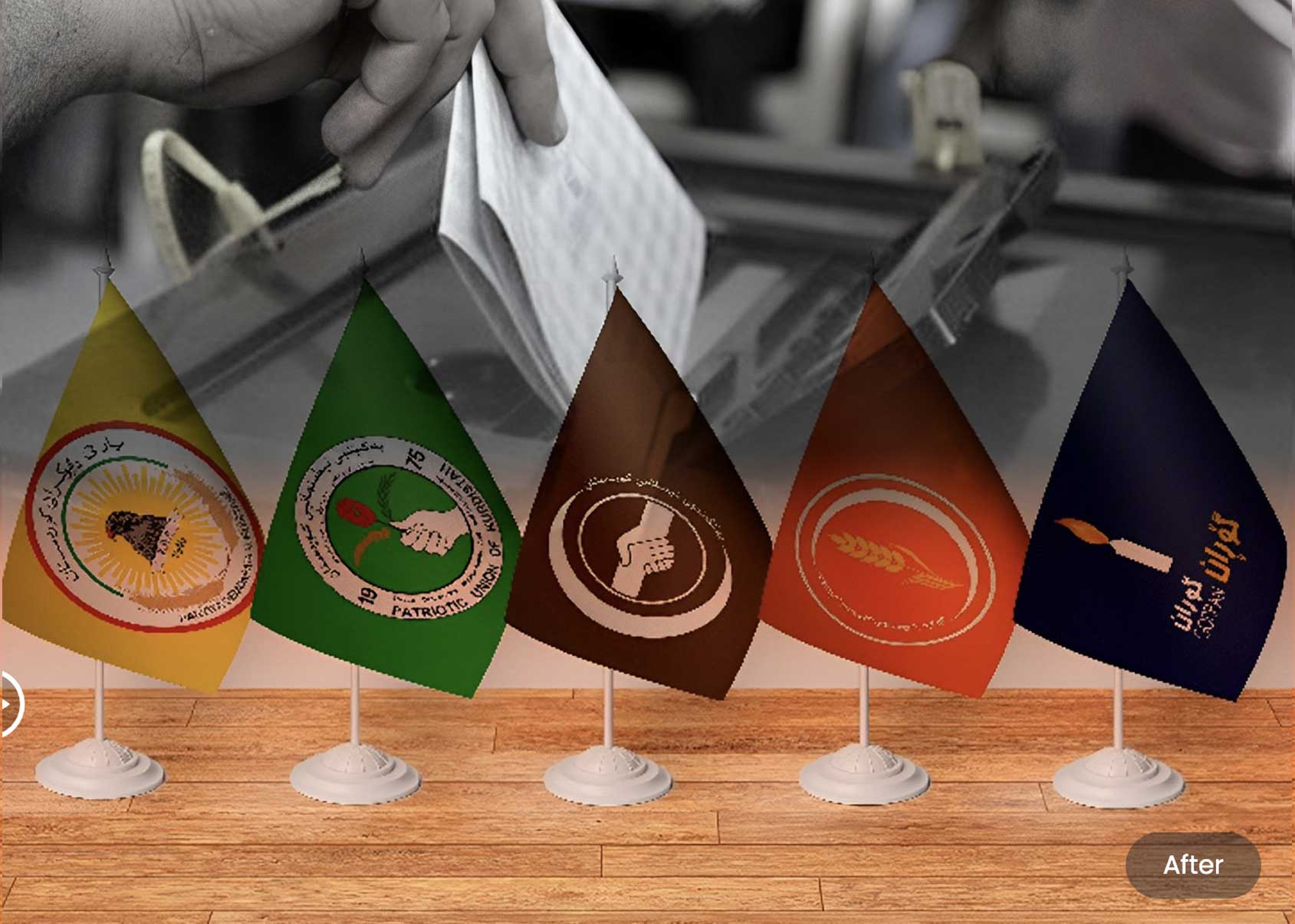Save for later
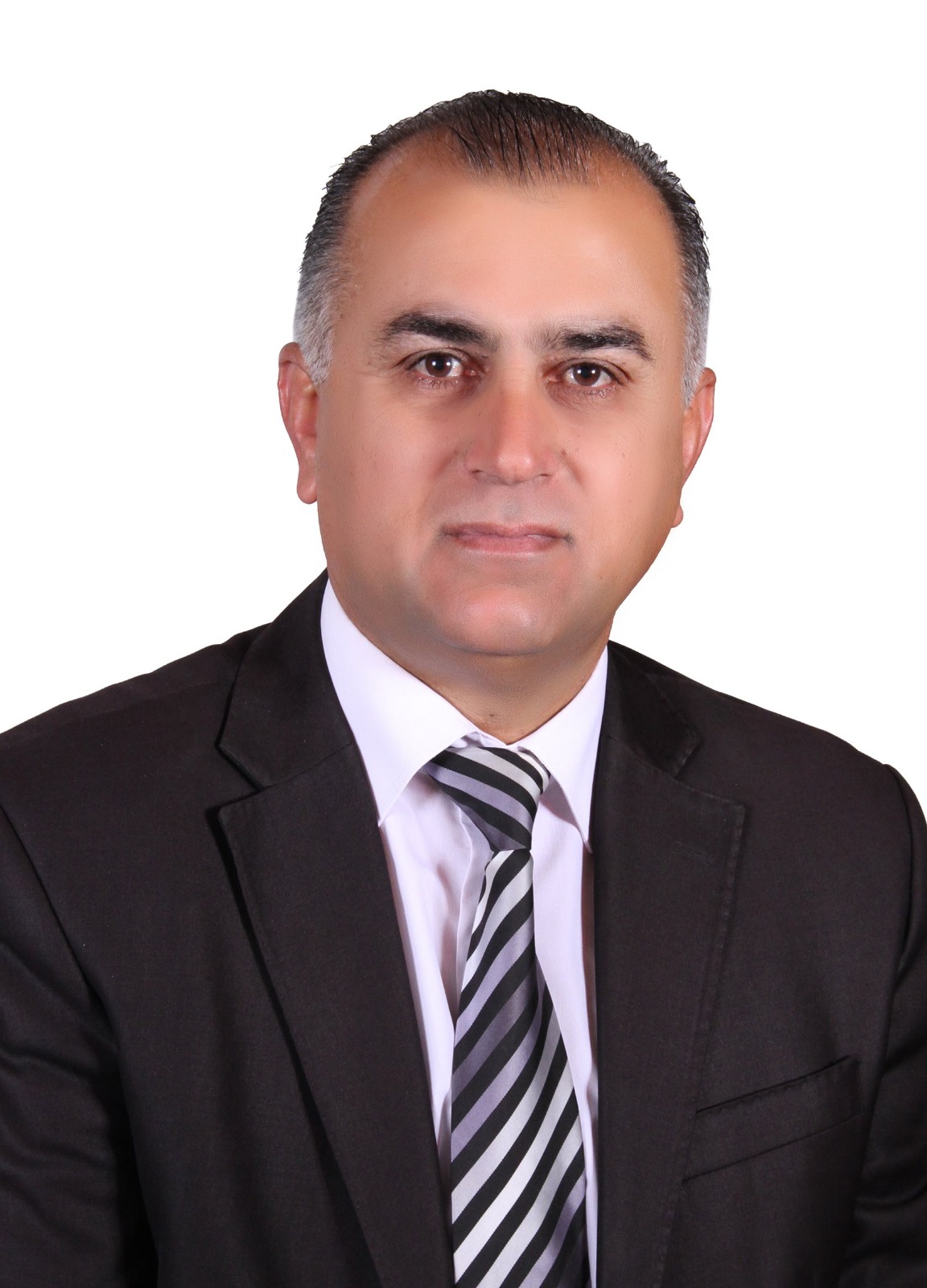 Dr. Khalil Karim Muhammad
Dr. Khalil Karim Muhammad
Professor in the Geography Department / College of Humanities / University of Sulaimani
The Drying Up of Iraq and the Kurdistan Region: A Study of Domestic Challenges and Transboundary Water Control
14-07-2025
Topics
- Executive Summary
- Introduction
- Part One: External Causes of Water Depletion in Iraq and the Kurdistan Region
- Water Depletion in Iraq and the Kurdistan Region Attributed to Turkey
- Table 01: Turkey’s Projects and Dams on the Euphrates and Tigris Rivers
- Water Depletion in Iraq and the Kurdistan Region Attributed to Iran
- Table 02: Iran’s Projects and Dams on the Alwand, Sirwan, and Little Zab Rivers
- Map 1: Water Depletion in Iraq and the Kurdistan Region Caused by External Sources and Neighboring Countries according to water and international boundaries
- Map 2: Water Depletion in Iraq and the Kurdistan Region Caused by External Sources and Neighboring Countries According to Provincial Boundaries.
- Part Two: Internal Causes of Water Depletion in Iraq and the Kurdistan Region
- Excessive Water Use and Declining Water Renewal in Iraq and the Kurdistan Region
- Graph 1: Annual Water Usage in Iraq by Category (2020–2022)
- Basic Water Stress: Water Usage and Renewal by Province in Iraq and the Kurdistan Region
- Graph (2): Future Trends of Total Water Extraction or Use in Iraq and Neighboring Countries (2030–2050 and 2080).
- Drought, Flooding, and Total Water Usage: Current Status and Future Projections
- Map 3: Basic Water Stress in the Provinces of Iraq and the Kurdistan Region
- Map 4: Drought Risk in the Provinces of Iraq and the Kurdistan Region
- Map 5: Scenarios of basic stress on water extraction in the provinces of Iraq and the Kurdistan Region in 2030.
- Climate Change in Iraq: Vulnerability and Adaptive Capacity
- Part Three: Diverging Trends: Population Growth and Water Renewal
- Graph 4: Population Growth in Iraq, Neighboring Countries, and Three Gulf States (1961–2035), Renewable Water Availability per Capita (Cubic Meters) in Iraq, Neighboring Countries, and Three Gulf States (1961–2035)
- Conclusion
- Sources
Executive Summary
Iraq and the Kurdistan Region have faced a major crisis from both external and internal dimensions: the water scarcity crisis. At present, Iraq and the Kurdistan Region are confronting an unprecedented threat of drought in their history, particularly as the annual renewable water availability per individual is currently approximately 600 cubic meters and is expected to decrease by half or more in the coming decade.
In terms of external causes of drying, Turkey emerges as one of the most significant factors. Since 1980, Turkey has constructed 16 major projects and dams on both the Tigris and Euphrates rivers within the framework of the GAP project. The Atatürk Dam, one of the four largest dams in the world, has the capacity to store 48.7 billion cubic meters of water and generate 2,520 megawatts of electricity. These projects have resulted in a 40% decrease in water inflow to Iraq and the Kurdistan Region, with Turkey currently controlling 88% of the Euphrates water and 56% of the Tigris water entering Iraq.
Iran, as another neighboring country, has constructed over 20 dams and projects on the shared rivers of Alwand, Sirwan, and Little Zab, with a storage capacity of 1.87 billion cubic meters of water on the Sirwan River alone. Iran has also completely dried some rivers, such as Kangir and Kanjan Cham, and since 2011 has openly declared its intention to cut off all rivers flowing from Iran to Iraq due to its own water scarcity.
From an internal challenges perspective, Iraq ranks fifth among the world’s highest water-consuming countries, with each individual using 1,410 cubic meters of water annually. The agricultural sector accounts for 73% of total water consumption, which reached 17.31 billion cubic meters in 2022. However, traditional irrigation methods are still in use, and approximately $5 billion worth of agricultural products are imported annually. At the same time, the country faces a major wastewater treatment issue, with only 1.09 billion cubic meters out of 11.25 billion cubic meters of wastewater being treated.
One of the most pressing ongoing challenges in Iraq is the growing population in contrast to declining renewable water resources. Currently, the population of Iraq and the Kurdistan Region stands at 46.1 million people, with each individual having access to 695 cubic meters of renewable water annually. By 2030, when the population is projected to reach 52 million, renewable water availability will decrease to 543 cubic meters per person. By 2035, with an estimated population of 57 million, renewable water will drop to 391 cubic meters per person, half of the current level. This is significantly below the international standard, which requires a minimum of 1,000 cubic meters per person.
The impact of this crisis is also evident in other sectors in Iraq. For instance, in the oil and gas sector, the production of each barrel of oil requires between 1.5 and 3 barrels of water, resulting in the use of 141 million cubic meters of water annually. In the Kurdistan Region, there are also 12 steel production companies that produce 4.7 million tons of steel per year and require 2.8 billion cubic meters of water.
According to the World Resources Institute, Iraq is among the 25 countries in the world with the highest level of basic water stress, scoring 4.14 out of 5. The most at-risk provinces are Al-Qadisiyyah, Najaf, Muthanna, and Kirkuk, while in the Kurdistan Region, Sulaymaniyah and Dohuk face the greatest risk. This water scarcity has become a driver of internal migration. In 2021, 20,000 people migrated due to these conditions; by 2023, the number had reached 130,000, and in 2024, it rose to 696,000. This reflects a 33.8% increase in migration driven by climate change and water scarcity across several Iraqi provinces over three years.
Projections indicate that by 2030, basic water stress will rise in all provinces, particularly in southern regions such as Najaf, Al-Qadisiyyah, and Karbala. Pressure on the population is expected to reach the highest level of 5 points, followed by the industrial sector at 4.5 points. Iraq also ranks 122nd globally in terms of readiness to confront climate change, placing it among the most vulnerable countries.
Finally, action is required on three levels: First, at the international level, to internationalize the issue at the United Nations and to oppose the alteration of water flow patterns by Turkey and Iran. Second, at the domestic level, by developing water infrastructure and investing in wastewater treatment. Third, at the individual level, by raising public awareness and establishing educational programs focused on the responsible use of water.
Introduction
The population of Iraq and the Kurdistan Region is increasing year by year, and the number of people migrating from villages to cities continues to rise. Meanwhile, the volume of water flowing in from external sources, as well as the amount collected internally on an annual basis, is decreasing and moving toward drought conditions. The annual renewable water availability per individual is now approximately 600 m³ and is projected to decrease by half in the coming decade. This stands in stark contrast to international standards, which stipulate that the minimum required water share per individual should not fall below 1,000 m³.
Iraq has long been known as the land of the two rivers, while the Kurdistan Region is characterized by its mountainous terrain, white peaks, and spring rains. The mountains of Kurdistan have historically functioned like a water tower, supplying surrounding areas with water from higher elevations. However, due to climatic factors and inadequate water management, we are now witnessing the drying of rivers, the reduction of spring water, the disappearance of natural water sources, and the cessation of inflows from neighboring countries. If Baghdad and Erbil do not cooperate effectively in the coming years, they will face a water crisis unparalleled in both ancient and modern history.
Currently, Iran has implemented several projects on shared rivers in the form of digging water channels to divert river and stream water. These include the excavation of three channels on the Banawe Soot stream, which is an important source of the Little Zab River, in addition to other projects on border rivers in the central and southern regions. All of these water projects undertaken by the Iranian state on rivers and streams have been carried out without considering the opinions or perspectives of the Iraqi state or the Kurdistan Region. The views of these parties have not been taken into account in any way, nor have decisions regarding these projects been made in consideration of the water interests of the Kurdistan Region, the Iraqi state, and Iran itself.
Since 1980, Turkey has established more than 16 large and small projects and dams on both the Tigris and Euphrates rivers as part of the GAP project, which is being implemented across nine provinces of the country. The total number of dams and power stations Turkey intends to construct on these two rivers amounts to 22 dams and 19 power stations, in addition to water diversion for agricultural and irrigation purposes. These completed dams and projects have caused a 40% reduction in the flow of water to Iraq, and this reduction continues to worsen each year.
Furthermore, according to collected data on the projects and dams constructed by Iran and Turkey on the major shared rivers, Iran primarily implements its projects for irrigation and providing drinking water for its population. In contrast, Turkey pursues its projects for both irrigation and energy production, including the construction of power stations.
In reality, while external factors and neighboring countries are indeed responsible for the water depletion in Iraq and the Kurdistan Region, Iraq itself is also internally moving toward increasing aridity. In all aspects of water-related challenges, Iraq is at a disadvantage compared to its neighboring countries in terms of dam construction and the utilization of water resources. Moreover, unlike the wealthy oil and gas-producing Gulf countries, Iraq has been unable to secure drinking water for its population, not only for the future but even for the present.
Iraq remains extremely vulnerable to climate change and water scarcity, ranking among the 25 most at-risk countries in the world, according to the World Resources Institute. Despite this alarming status, annual water renewal per capita, as reported by the World Bank, continues to decline year after year. At the same time, the exploitation of both groundwater and surface water for industrial, agricultural, residential, and household use is steadily increasing (FAO, AQUASTAT, 2022).
This paper presents the efforts of Iraq and the Kurdistan Region’s neighboring countries in constructing dams and ponds, diverting water flow sources for internal needs, and the implications for annual water renewal. It also offers projections for Iraq’s future in the context of drought and provides solutions for ensuring adequate water supply for the population, industry, agriculture, and environmental needs, both now and in the future.
Part One: External Causes of Water Depletion in Iraq and the Kurdistan Region
Iran and Turkey are neighboring countries that share borders with Iraq and the Kurdistan Region, with four main transboundary rivers flowing between them. Turkey shares the two principal rivers—the Tigris and the Euphrates—while Iran shares the Alwand, Sirwan, and Little Zab rivers. In addition, Iran shares several smaller rivers such as the Kangir and Kanjan basins.
The history of these two countries in blocking the flow of shared river waters, altering the natural direction of watercourses, and constructing dams, barriers, and water reservoirs dates back nearly a century. However, in the past decade, the issue has intensified due to climate change, particularly rising temperatures and reduced or irregular annual precipitation. As a result, the reduction in water flow and violations of international waterway agreements have become pressing concerns.
Currently, Iraq and the Kurdistan Region are facing a severe summer due to the significant decrease in water inflow. According to Iraq's Ministry of Environment, a drought of this magnitude has not been witnessed in the past 80 years. In the Kurdistan Region, not only are rivers approaching a state of drought, but the water levels in dams have also dropped to historic lows. While part of this decline is attributable to reduced annual rainfall, the greater cause lies in the construction of dams, barriers, and reservoirs by Iran on the Sirwan and Alwand rivers and by Turkey on the Tigris and Euphrates rivers. Furthermore, these interventions have gone beyond dam construction to include altering the direction of water flow—actions that may not only deprive Iraq of water for a few years but could eventually result in a complete cessation of water flow from these rivers.
For nearly half a century, Turkey has been implementing the construction of 22 dams and 19 power stations across nine provinces of the country. According to collected data, 16 projects and dams on both the Tigris and Euphrates rivers are nearing completion or have already been implemented. These projects also include altering the direction of water flows used for agriculture and irrigation. Consequently, some sources indicate a reduction of up to 40% in the volume of water reaching Iraq, and in the coming years, this figure may exceed 60%, potentially leading to complete drought.
One of the most significant projects is the Atatürk Dam, which is considered one of the four largest dams in the world. It has a storage capacity of 48.7 billion cubic meters of water and generates 2,520 megawatts per hour of electricity. Additionally, it provides irrigation for 870,000 hectares of agricultural land. In conjunction with this dam, the Urfa Tunnel was constructed in the form of two channels, one of which is 26.4 kilometers long and has the capacity to transfer 328 cubic meters of water per second. Furthermore, three additional channels, measuring 283 kilometers, 150 kilometers, and 200 kilometers in length, were constructed. This system is considered the largest tunnel ecosystem for water transfer in the world. The threat posed by this project to Iraq and Syria lies not only in the accumulation of water and reduction of Euphrates flow but also in the alteration of the Euphrates River’s course from its natural path to an artificial one, thereby changing the river’s nature.
To date, the projects Turkey has constructed on this river are capable of storing 16.872 billion cubic meters of water. In addition, Turkey has proposed projects on the Great Zab, which include the Upper Zab Dam, Solut, Çaldıran, Bani Berz, Hakkari, Dilili, and Tibiyan, as well as plans for constructing the Doğanlı, Çukurca, Aslandam, and Buyurdu dams[i].
Iran, which considers Iraq and the Kurdistan Region to be close friends and strategic partners, has, for several decades, completely dried up three shared rivers and is on the path to drying the Sirwan, Alwand, and even the Little Zab rivers.
[i] Fuad Qasim Al-Amir, Water Balance in Iraq and the Global Water Crisis, translated by Dr. Khalil Karim Mohammed and Ahmed Ali Ahmed, 2016, p. 166.
Water Depletion in Iraq and the Kurdistan Region Attributed to Turkey
Turkey's water policy is based on both natural geographical and human foundations. As a result, the country is rich in water resources and annually receives more than 203 billion m³ of water. It experiences approximately 600 billion m³ of annual precipitation, which recharges 26 main rivers. Of this, 196 billion m³ is obtained domestically, and 7 billion m³ comes from outside its borders, in addition to more than 9.5 billion m³ of groundwater.
In light of these data, it becomes evident that Turkey's water policy—particularly regarding the two major rivers, the Tigris and Euphrates—serves more than just economic purposes; it also pursues political, security, and social objectives[i]. Since the second half of the twentieth century, Turkey has emphasized the goal of maximizing the benefits of its water resources. This strategy is exemplified by the Southeastern Anatolia Project (GAP), which lies entirely within Northern Kurdistan. The project covers an area of 75,358 km² and irrigates 605,890 hectares of land located between the Tigris and Euphrates basins, requiring a substantial amount of water.
The project comprises 22 dams, 19 hydroelectric stations, and an extensive irrigation network. Most of the dams are major, in addition to 45 smaller dams constructed on various tributary rivers and seasonal waterways. These dams have the capacity to store approximately 25 billion m³ of water.
It is evident that Turkey is unlikely to halt these initiatives and will continue constructing similar projects on all valleys, channels, and waterways, particularly those near the borders with the Kurdistan Region. This increases the threat to the Kurdistan Region, as projects along the Tigris River directly affect its water resources.
The danger posed by Turkey's water policy to both the Kurdistan Region and Iraq stems from the fact that 56% of the Tigris River's water in Iraq originates in Turkey, 32% comes from within Iraq, and the remainder from Iran. Regarding the Euphrates, 88% of its water in Iraq comes from Turkey, 9% from Syria, and only 3% from within Iraq.
[i] Khali Jawad Salman, The Impact of Neighboring Countries' Policies on the Future of Water Resources in Iraq, Journal of the Islamic College of Education for Educational and Human Sciences, University of Babylon, Issue 36, December, 2017.
Table 01: Turkey’s Projects and Dams on the Euphrates and Tigris Rivers
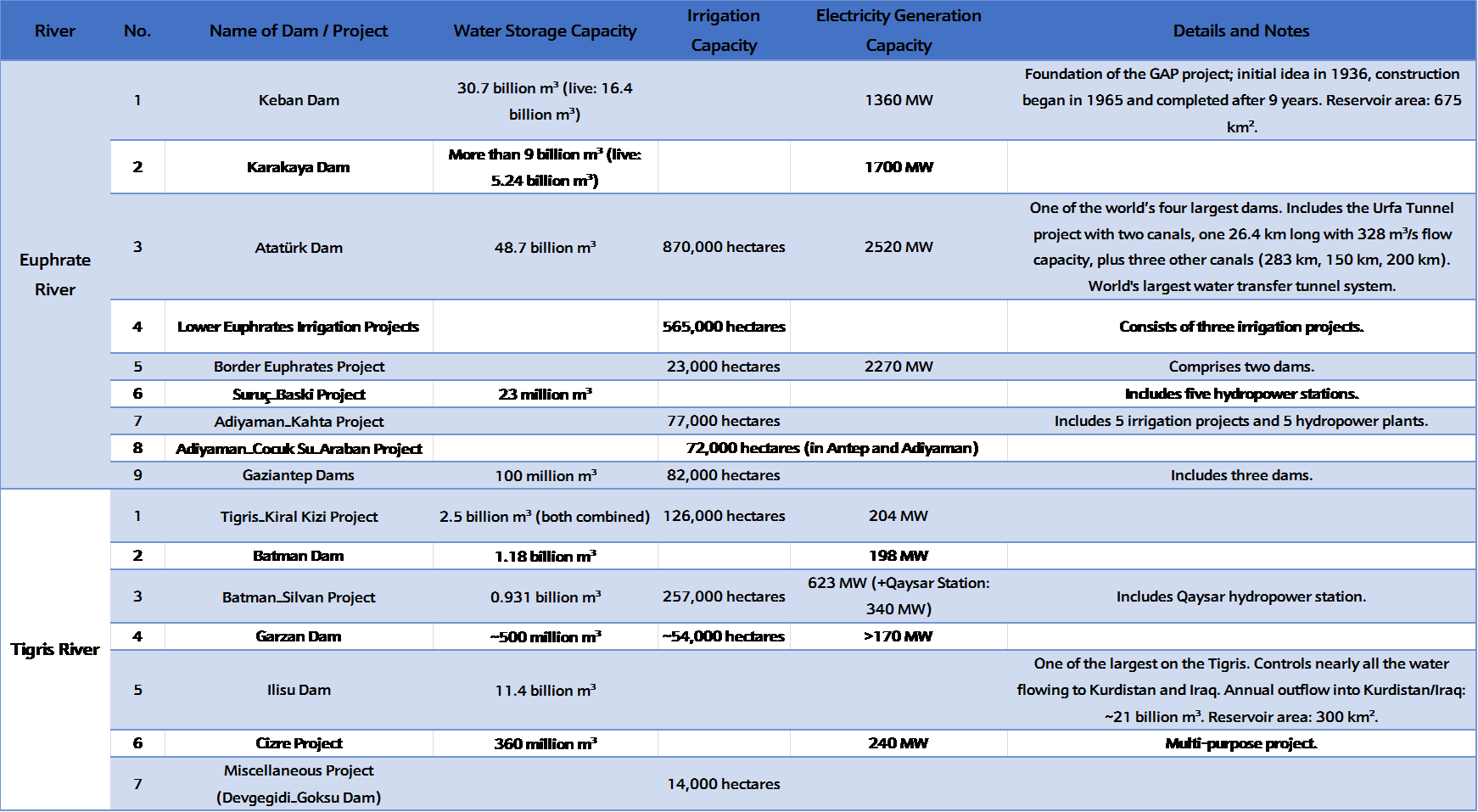
Water Depletion in Iraq and the Kurdistan Region Attributed to Iran
The Iranian state controls seven key water sources that flow into the Kurdistan Region and Iraq. The Kurdistan Region does not have the ability to assert its sovereignty over these river sources—including the Tigris River, Great Zab, Little Zab, Sirwan, Hawasan, Qorato, and Alwand Rivers—because most of them have extensive basin areas and water spring sources located outside the geographical boundaries of the Kurdistan Region.
Currently, the Iranian state is systematically investing in its water resources, as the amount of rainfall in Iran has decreased by 20%, and the volume of water that can be stored in its dams has declined by 33%, dropping from 32 billion m³ to 25 billion m³. As a result, this available water is insufficient to meet the country's crop irrigation and energy production needs, forcing Iran to address its food and energy shortages by capturing more river water.
Iranian hydrology and climate experts stress that if the state does not develop its water resources carefully, it will face serious challenges in the coming years. It is not far-fetched to anticipate mass migration and the transformation of water-scarce regions into desertified areas[i].
Since 2011, Iran has explicitly announced to Iraq its intention to cut off all rivers flowing from Iran into Iraq due to water scarcity within its own borders. This policy has caused significant problems for the Kurdistan Region, ranging from declining river water levels to the complete drying of some rivers, such as the Alwand and Qorato.
The negative impacts of this Iranian water policy have manifested in the agricultural sector and the environment of Iraq generally, and the Kurdistan Region in particular. These effects include a reduction in available drinking water and alterations in the morphology of water basins.
Iran's water policy has severely damaged the water resources of the Kurdistan Region, as, apart from the rivers originating from Iran, there are no other major water sources in extensive areas such as Garmian. Iran’s strong pressure on transboundary water with the Kurdistan Region is driven by its geographical and climatic conditions: Iran is a vast plateau surrounded by high mountains, causing humid cyclones to reach it slowly, resulting in a predominantly dry climate. Only the Kurdistan and northwestern Azerbaijan regions receive substantial rainfall and have abundant water resources. To revive its arid plains, develop agriculture, and specifically to irrigate approximately 180,000 hectares of agricultural land and provide food for around 90 million people, Iran requires a significant volume of water. To meet this demand, it heavily invests in water resource development.
Table 02: Iran’s Projects and Dams on the Alwand, Sirwan, and Little Zab Rivers
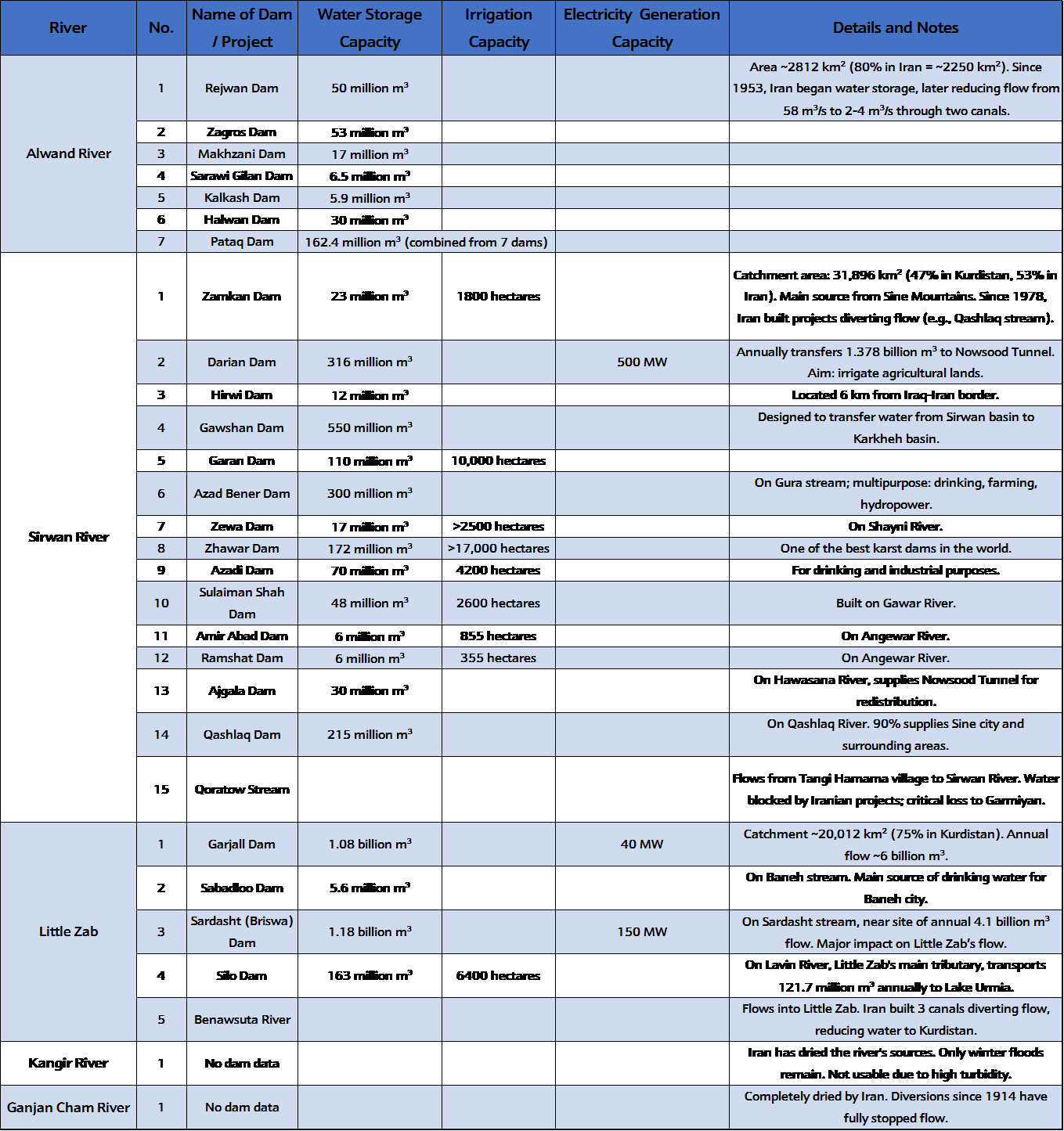
Map 1: Water Depletion in Iraq and the Kurdistan Region Caused by External Sources and Neighboring Countries according to water and international boundaries
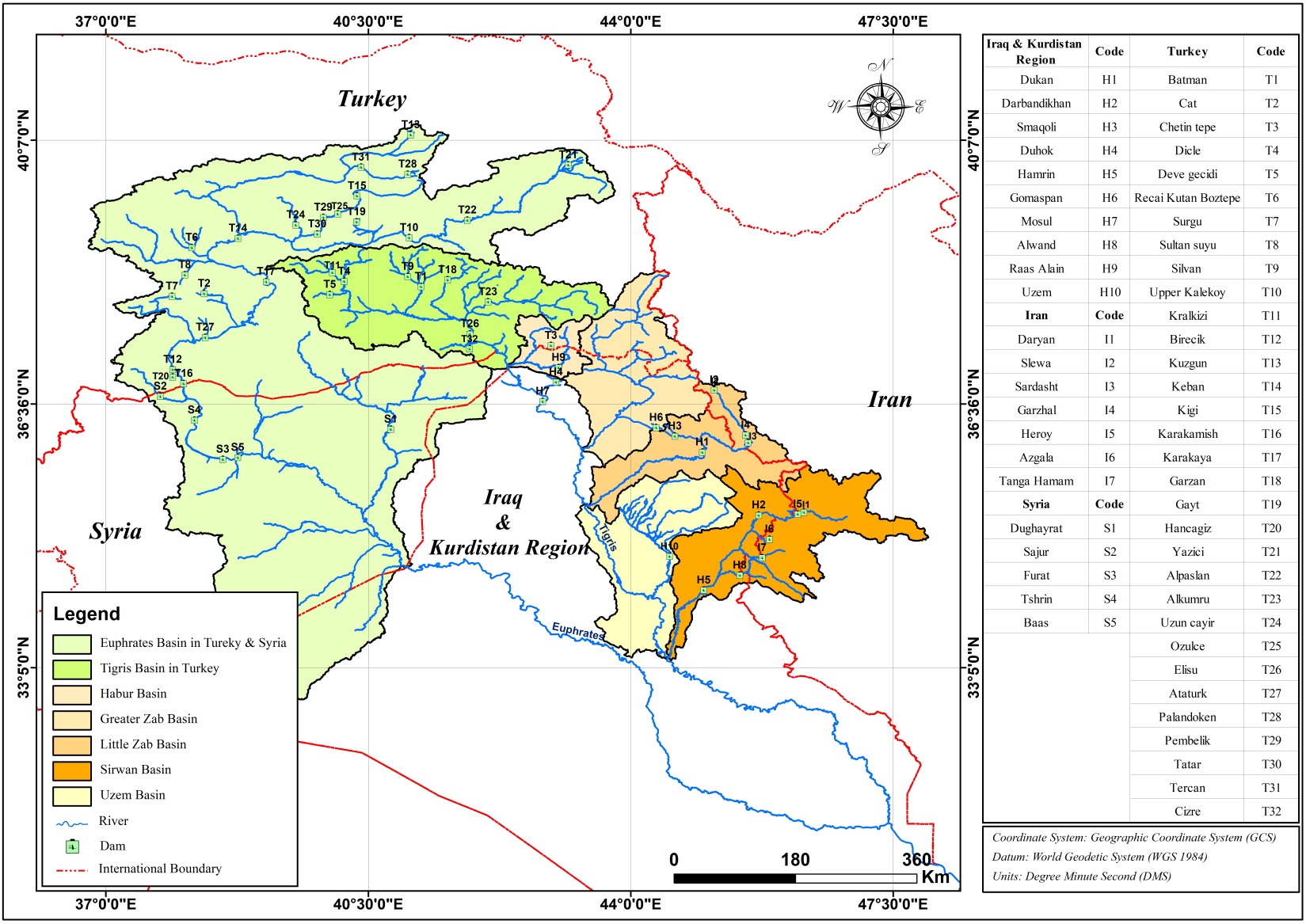
Source: Researchers’ work based on GIS 10.8 software
Map 2: Water Depletion in Iraq and the Kurdistan Region Caused by External Sources and Neighboring Countries According to Provincial Boundaries.
Source: Researchers’ work based on GIS 10.8 software
Part Two: Internal Causes of Water Depletion in Iraq and the Kurdistan Region
The wasteful use of internal water resources in Iraq and the Kurdistan Region continues, causing the country’s ranking among nations vulnerable to water scarcity and increasing pressure on water resources to worsen year by year. This is because the daily water consumption exceeds the necessary amount and continues to rise, while the volume of water collected internally and received from external sources is decreasing.
Population growth and the decline in annual water renewal due to climate change place Iraq at greater risk of water scarcity in the coming decade. Each Iraqi consumes approximately 1,410 m³ of water per year, ranking as the fifth highest individual water consumer in the world. Although high water consumption itself is not the primary problem, wasteful use without productivity constitutes a serious issue. It is well documented that water wastage in Iraq is a severe and evident phenomenon.
According to FAO AQUASTAT data, Iraq’s access to suitable water resources is declining annually. For example, over the past five years, the total volume of water from both internal and external sources has decreased from 100 billion m³ to below 90 billion m³ per year, representing a reduction of 10 billion m³ in surface and groundwater between 2018 and 2021.
According to the latest census, the population of Iraq and the Kurdistan Region is 46,118,793 people, with the urban population rate rising to 70.17%. If consumption demand remains at the current level, the annual water requirement reaches 65 billion m³, while the total amount of renewable water—both internal and external—currently reaches 89.8 billion m³. This amount is decreasing annually without accounting for environmental needs (ecological system). For example, in 2022, internal water resources decreased to 35.2 billion m³, and externally sourced water dropped to 54.6 billion m³ per year.
Another aspect contributing to Iraq’s water scarcity is the continued use of outdated and traditional agricultural methods, which account for over 70% of water consumption, despite Iraq annually importing agricultural products valued at over $5 billion from abroad. Meanwhile, both governments have adopted the practice of digging new wells to supply drinking water for homes and residents. In the Kurdistan Region alone, the number of legal and registered wells in 2021 for household drinking water was 12,374, for agricultural purposes 10,986, and for commercial purposes 950 wells. At the same time, in the provinces of the Kurdistan Region, the number of illegal wells dug without government permits exceeds the number of permitted wells. This exploitation of groundwater poses a serious and dangerous factor contributing to the depletion of groundwater sources. According to international practices, groundwater should be treated as a strategic resource—protected and utilized only in essential situations.
Notably, in Iraq and the Kurdistan Region, the digging of wells, particularly illegal ones, outside official institutions and independently by residents, is increasing. Monitoring reports indicate that the number of illegal wells without permits is rising. Residents of major cities and even villages near the two rivers now must dig wells twice as deep as before to access water. According to the latest report by Rudaw Media Network (February 2025), throughout the Kurdistan Region, groundwater levels have dropped by 5 to 30 meters over the past 10 years.
Excessive Water Use and Declining Water Renewal in Iraq and the Kurdistan Region
The decline in annual water availability in Iraq has led to a significant reduction in overall consumption and access, especially for residents and households. As a result, in several areas of the Kurdistan Region, according to statements by administrative officials, household water supply now returns only once every 11 days or more. In Iraq as a whole, water scarcity is not limited to temporary periods or summer months; it has caused population displacement and forced people to abandon areas where their families have farmed and lived for decades. For example, due to severe water shortages in southern provinces such as Muthanna, Dhi Qar, and Babylon, many residents are migrating. According to the latest report by the International Organization for Migration (IOM), in 2024, out of 18 provinces monitored, approximately 168,696 people were displaced due to climate change and other environmental factors, particularly water scarcity. This represents an increase from 130,000 displaced persons in 2023 and 20,000 in 2021—an increase of 740% over three years, or nearly sevenfold. Most of this migration is attributed to water shortages in provinces such as Dhi Qar, Diwaniyah, and Maysan.
Currently, most water use in Iraq, as is the case globally, is dedicated to agricultural purposes. In 2022, out of a total of 42.4 billion cubic meters (m³) of water used, approximately 31.17 billion m³—equivalent to 73% of the total—was allocated to agriculture. Meanwhile, the agricultural sector’s contribution to Iraq’s total GDP growth was 2.8%, amounting to 7.5 billion dollars. In recent years, industrial water consumption has increased, rising from 3.84 billion m³ in 2020 to 4.52 billion m³ in 2022, representing a 2% increase. Notably, household and residential water use declined, decreasing from 8.5 billion m³ in 2020 to 6.7 billion m³ in 2022.
Graph 1: Annual Water Usage in Iraq by Category (2020–2022)
Source: Food and Agriculture Organization (FAO) AQUASTAT data, June 1, 2025
Generally, producing one barrel of oil—which currently amounts to approximately 4.5 million barrels daily in Iraq and the Kurdistan Region—requires between one and a half to three barrels of water. This technique has been continuously used in Iraq since 1950 for oil extraction, utilizing water sourced from rivers, streams, groundwater, and other suitable sources. For example, the Basra oil fields alone require between 4,500 and 5,000 liters of water per second for daily oil production. This equates to a minimum daily water requirement of approximately 388 million liters, and an annual requirement of 141 million cubic meters at the current production level. This water is supplied primarily from the Hafer and Euphrates rivers, rather than the Shatt al-Arab, due to the unsuitability of the latter's water.
In the Kurdistan Region, the steel industry and oil refining sectors have also developed. Of the 14 iron production companies in Iraq, 12 are located in the Kurdistan Region, while the remaining two are in Basra and Nineveh provinces. These companies collectively produce 4.7 million tons of iron annually, requiring 2.8 billion cubic meters of water sourced from rivers or groundwater.
Currently, within the Kurdistan Region, approximately 300,000 barrels of oil are produced daily. Of this, over two-thirds—approximately 200,000 barrels—are refined internally through small legal and illegal refineries. Refining each barrel of oil requires 300 liters of water; thus, annually, the water used in this sector, sourced from surface and groundwater, amounts to 60,000 cubic meters in the Kurdistan Region alone. This sector is expanding throughout Iraq and the Kurdistan Region, and with the operation of new factories, an additional 1.9 billion cubic meters of water consumption is expected to increase.
Meanwhile, the annual water consumption in cement production across Iraq and the Kurdistan Region reaches 101 million cubic meters, with most factories relying on groundwater or rivers and streams to sustain daily cement production.
In 2022, the total water used annually for industrial and household purposes reached 11.25 billion cubic meters, of which only 1.09 billion cubic meters were treated. Consequently, over 10 billion cubic meters of water became polluted after use, contaminating other water sources—including rivers, surface water, and groundwater—without the possibility of reuse.
From another perspective, the amount of stored or accumulated water in dams, ponds, rivers, and reservoirs across Iraq is decreasing annually due to evaporation. For instance, according to FAO data, the per capita water storage in Iraq was 3,604 cubic meters in 2020, but it declined to 3,444 cubic meters in 2022. The two main causes of this decline are reduced water inflow and evaporation.
Basic Water Stress: Water Usage and Renewal by Province in Iraq and the Kurdistan Region
The basic stress level on water, or water risk, refers to the gap between water demand and supply, occurring when the annually renewable water is less than the amount being used. This imbalance increases the stress on renewable water resources. The stress level is measured on a scale from 1 to 5, where values below 1 indicate the lowest stress, and 5 represents the highest and most severe water stress.
According to the World Resources Institute (WRI) and its latest Aqueduct water stress map, 25 countries—home to one-quarter of the world’s population—face severe water challenges annually, continuously consuming all their available water resources. Moreover, at least 50% of the global population, approximately 4 billion people, experience the highest level of water scarcity stress for at least one month each year.
Iraq is among these 25 countries with the highest basic water stress levels, where water demand exceeds available supply. This situation is driven by population growth, industrial activity, agriculture, electricity production, and manufacturing.
According to available data, Bahrain, Cyprus, Kuwait, Lebanon, Oman, and Qatar are among the countries facing the highest levels of risk related to increased stress on water use and water renewal. Iraq, with a score of 4.14, ranks among the countries experiencing the highest levels of stress in both categories—water use and water renewal.
Furthermore, based on three future scenarios—continuation of current trends, optimistic, and pessimistic—regarding water use or extraction for the years 2030, 2050, and 2080 in Iraq and the broader Middle East, especially Iraq’s neighboring countries, the trend shows a significant worsening of water use in all three scenarios. The gap between water demand and supply capacity narrows sharply, deteriorating to the extent that Iraq is projected to surpass Iran in water stress due to increased demand, as illustrated in the graph below.
Additionally, Iraq differs from its neighboring countries in all aspects of water use, as it is expected to experience a substantial increase in water consumption in the future. This increase applies to population, industrial, irrigation, and agricultural sectors, with growth rates exceeding those of neighboring countries in every category. For instance, focusing solely on water use for population and households, Iraq’s score is projected to rise from 11.584 in 2030 to 14.285 in 2050, reflecting an increase of 2.701 points. In comparison, the corresponding increases for Turkey, Syria, and Iran are 1.288, 0.888, and 0.448 points, respectively. This indicates that Iraq’s increase is approximately twice that of Turkey, three times that of Syria, and four times that of Iran, as shown in the graph below.
Graph (2): Future Trends of Total Water Extraction or Use in Iraq and Neighboring Countries (2030–2050 and 2080).
Source: World Resources Institute (WRI), May 10, 2025
Drought, Flooding, and Total Water Usage: Current Status and Future Projections
The current level of water use in Iraq and some of its provinces amounts to approximately 80% of the renewable water resources, encompassing both groundwater and surface water sources. Even during the shortest or mildest drought periods, these areas experience water shortages, resulting in the drying up of water transmission pipelines and household wells—an occurrence that is increasingly common across many locations, districts, and provinces. Regarding overall basic water stress, considering the combined water use for irrigation, livestock, industry, and population demands, the provinces most at risk are Qadisiyyah, Najaf, and Muthanna, ranking first, second, and third, respectively. In contrast, when comparing annual water renewal to usage, the provinces of Nineveh, Dohuk, and Basra exhibit a lower risk of imbalance between demand and supply relative to other Iraqi provinces, indicating a reduced level of water stress, as illustrated in Map 3
Map 3: Basic Water Stress in the Provinces of Iraq and the Kurdistan Region
Source: World Resources Institute (WRI), May 10, 2025
At the provincial level in Iraq and the Kurdistan Region, Sulaymaniyah Province ranks first with a drought risk score of 3.66 points, followed by Kirkuk Province with 3.46 points, and Dohuk Province with 3.45 points. These rankings are based on the combined assessment of drought risk across three sectors: agriculture, industry, and households. Regarding the potential for flood formation from rivers, Dhi Qar Province ranks first with 4.12 points, followed closely by Muthanna Province with 4.11 points, and Maysan Province with 4.08 points at the national level.
Map 4: Drought Risk in the Provinces of Iraq and the Kurdistan Region
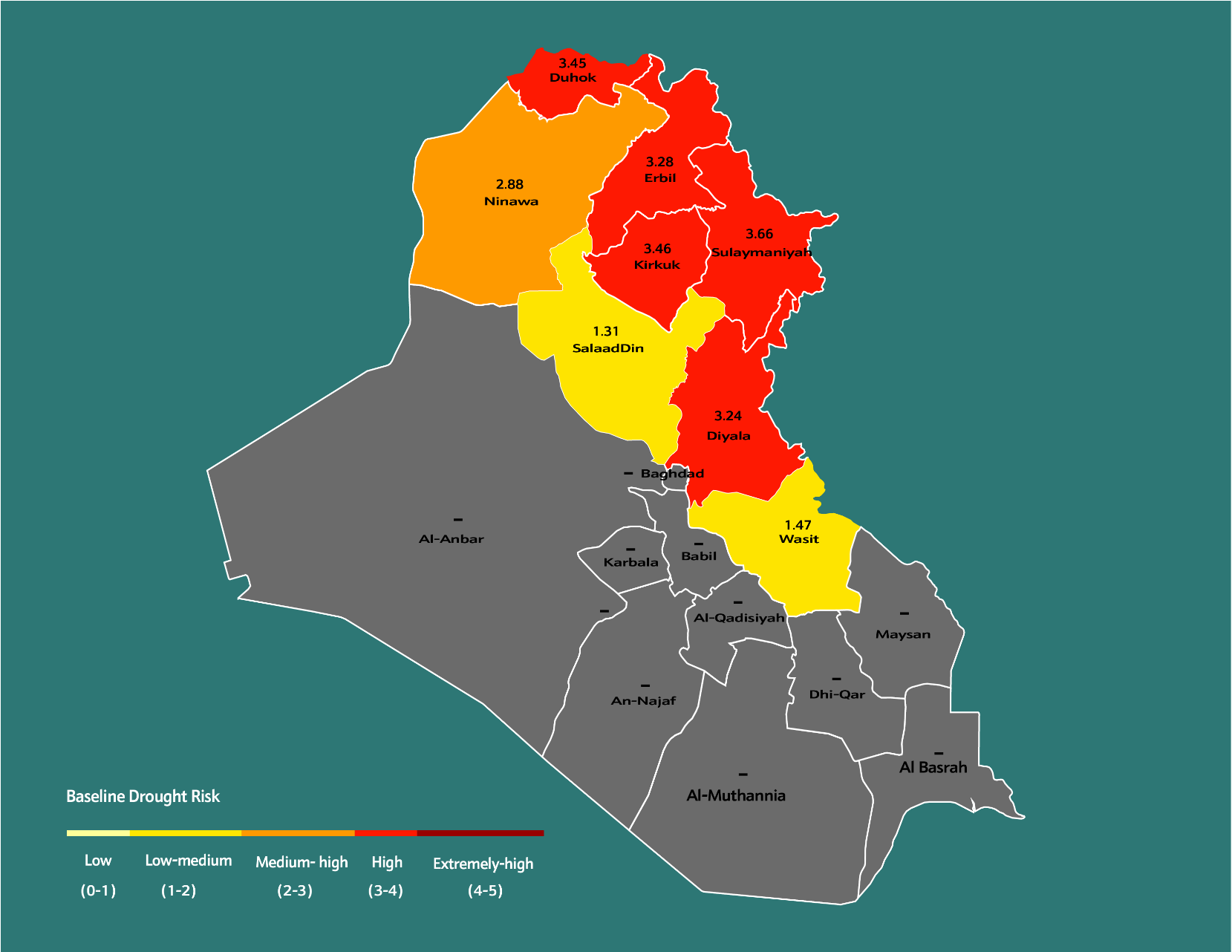
Source: World Resources Institute (WRI), May 10, 2025
Note: Out of the 18 Iraqi provinces for which drought risk data is presented by the World Resources Institute (WRI), data is available for only 8 provinces, most of which are in the Kurdistan Region.
According to predictions by the World Resources Institute for the coming decades (2030, 2050, and 2080), Iraqi provinces experiencing basic water stress are increasingly concentrated in the southern regions, extending to the central provinces and the Kurdistan Region. Across all three scenarios—continuation of current trends, optimistic, and pessimistic—the provinces of Najaf, Qadisiyyah, and Karbala consistently rank first, second, and third, respectively, regardless of the scenario, as illustrated in the graph below.
Furthermore, regarding the sources of water extraction stress in the coming decades, all Iraqi provinces will experience pressure primarily from population growth and household demand, reaching the highest levels of stress (a score of 5 or 4.998) in 2050 and 2080. The industrial sector follows, with a stress level of 4.5 points in all provinces by 2050. Stress related to irrigation and livestock also increases, though not to the same extent as household and industrial demands, as shown in the map below.
Map 5: Scenarios of basic stress on water extraction in the provinces of Iraq and the Kurdistan Region in 2030.
Source: World Resources Institute (WRI), May 10, 2025
Climate Change in Iraq: Vulnerability and Adaptive Capacity
Iraq has not been among the countries that caused climate change; however, now and in the coming decade, it faces a series of major challenges due to its impacts. These include the reduction of water resources, recurrent dust storms, pollution of water sources, decline in fertile soil and agricultural productivity, expansion of infertile land and desertification, prolonged summers, and shortened winters. Rising temperatures have compelled the government to periodically declare official holidays and close public places during daytime hours.
Whereas in past years discussions and concerns in Iraqi society and among rural residents of Kurdistan focused on the depletion of well water and the drying or reduction of spring water, there is now increasing talk of drying streams and tributary rivers, as well as a significant reduction in the main water flow of the four major rivers to the extent that the daily needs of residents in provinces, districts, and sub-districts cannot be met.
The rate of climate change in Iraq is twice that occurring globally. This means that when global temperature increases are discussed at 2 degrees Celsius, the equivalent rise in Iraq is approximately 4 degrees Celsius. Consequently, international institutions and experts now regard Iraq as one of the countries where climate change has manifested across all sectors. They call for Iraq to be treated as a laboratory for adaptation, disaster prevention, and resilience-building, aiming to establish it as a successful model for confronting climate change in the future. The pressing question remains: Is Iraq ready, and can it fulfill this role?
The University of Notre Dame, through an initiative, publishes an index evaluating countries’ adaptation to climate change from two perspectives. The first perspective assesses countries’ vulnerability in areas such as food production and agriculture, reduction of river water, and groundwater availability. The second perspective evaluates a country’s readiness, considering factors like governance, political stability, control of corruption, quality of law and rule of law, infrastructure, and social inequality.
In the Middle East and North Africa region, except for Yemen, Syria, and Lebanon—which rank worse than Iraq in both vulnerability and readiness—these four countries have a combined GDP that does not reach half of Iraq’s. Furthermore, Iraq’s monthly income is twice or more than the annual budgets of those countries, some of which continue to suffer from war and conflict.
According to the index, Iraq has a high vulnerability score and a low readiness score. The vulnerability measure ranges from 0 to 1, where a value closer to 1 indicates greater vulnerability; conversely, for readiness, a value closer to 1 indicates higher preparedness.
In terms of vulnerability, Iraq scored 0.433, and in terms of readiness, it scored 0.305, placing it among the worst-ranked countries globally, with an overall ranking of 122nd. The graph below illustrates Iraq’s readiness and vulnerability in comparison to neighboring countries. Additionally, regarding food security, Iraq’s most critical weakness is its agricultural capacity, which scored 0.927, comparable to countries such as Malawi, India, and Lithuania.
Graph 3: Comparative Adaptive Capacity and Water Reduction Vulnerability in Iraq, Neighboring Countries, and Gulf States (2022)
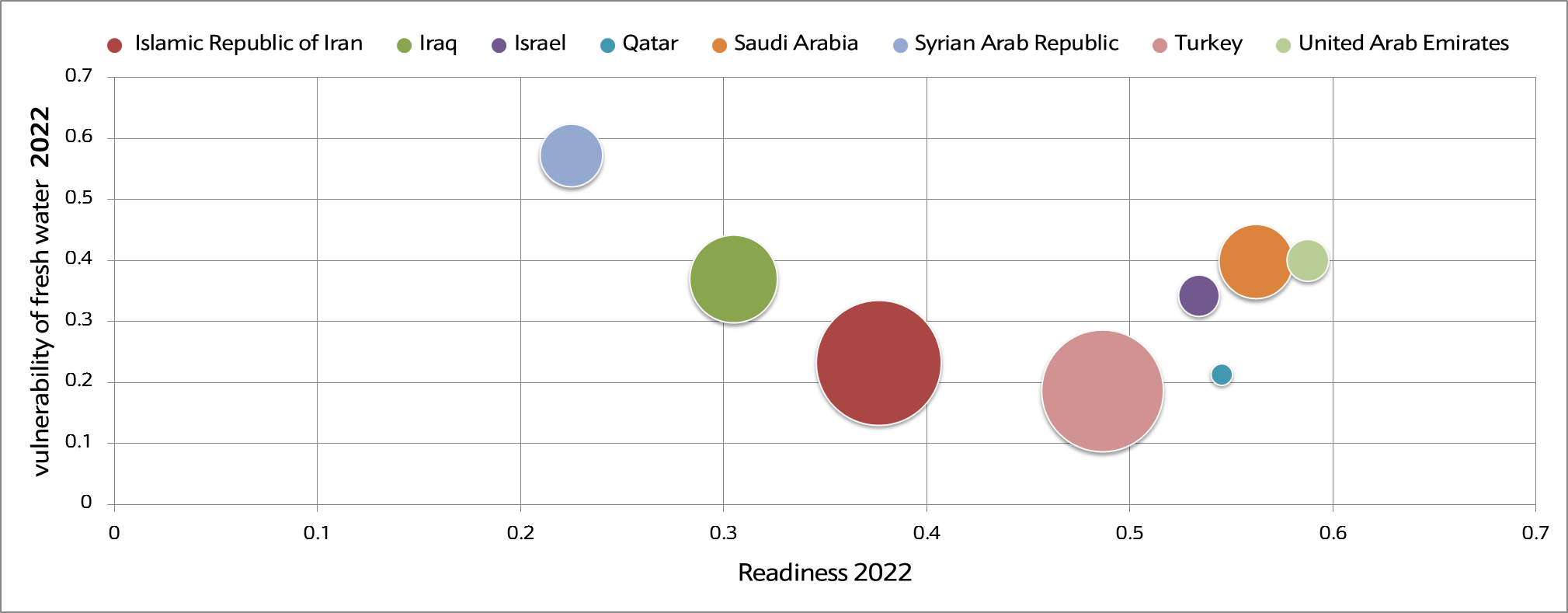
Source: University of Notre Dame Index, June 22, 2025; World Bank Group, June 23, 2025.
Note: The size of the circles corresponds to the population size of each country.
Part Three: Diverging Trends: Population Growth and Water Renewal
An important issue that distinguishes Iraq from its neighbors and Gulf countries—and one that is worsening at an accelerating rate each year—is the decreasing amount of renewable water available per capita alongside rising population numbers. Over the next five years (2025–2030), Iraq's population is projected to reach 52 million. However, during the same period, the renewable water available per individual is expected to decline from 695 m³ to 543 m³. By 2035, this figure will be reduced by half, reaching 391 m³ per individual. Refer to Graph 6 for details.
Iraq, similar to Saudi Arabia, is the second-largest daily oil exporter in OPEC and ranks close to Qatar in natural gas reserves. However, unlike Qatar, which is an exporter, Iraq is a natural gas importer. Over the next five years (2025–2030), Saudi Arabia is projected to increase renewable water availability per capita by 5.46%, and Qatar by 24.56%, whereas Iraq is expected to experience a decline of 28%. During the same period, Qatar's population is projected to grow by 2.76%, Saudi Arabia’s by 5.82%, and Iraq’s by 9.66%.
In the coming years, among its neighboring countries, only Syria faces a water renewal situation as dire as Iraq’s. However, Syria’s population growth trend is declining, and by 2035, its population is projected to decrease to 24 million. In contrast, Iraq’s population is expected to exceed 57 million by 2035.
Graph 4: Population Growth in Iraq, Neighboring Countries, and Three Gulf States (1961–2035), Renewable Water Availability per Capita (Cubic Meters) in Iraq, Neighboring Countries, and Three Gulf States (1961–2035).
Source: World Bank Group data, June 23, 2025
Note 1: Data from 2024 to 2035 are forecasts by researchers
Note 2: Data from 2022 to 2035 are forecasts by researchers
Conclusion
In light of the policies adopted by neighboring states, Kurdistan and Iraq face the threat of significant reductions and even complete cutoff of their main rivers. For instance, Iran alone has the capacity to store 162.4 million m³ of water on the Alwand River, while the average annual water flow is approximately 63 million m³. On the Sirwan River, Iran’s storage capacity is 1.875 billion m³, whereas the annual water flow is 0.63 billion m³. Regarding the Little Zab River, Iran’s storage capacity reaches 1.31 billion m³, while the average annual flow of the river is 6 billion m³. Turkey annually obtains 5.37 billion m³ of water from the Great Zab River. Currently, projects on the Tigris River have a total storage capacity of 16.872 billion m³. To fill these reservoirs, Turkey would need to block the entirety of the Tigris River’s flow for approximately two years, even when considering only the 32.94 billion m³ of water that flows from Turkey into Iraq.
As for the Euphrates River, Turkey’s projects have effectively dried the river, since 88% of the Euphrates water entering Iraq originates from Turkey, indicating complete Turkish control over this river’s flow. The river basins of Kurdistan’s rivers cover 57.25% of their total area within the Kurdistan Region’s borders and have an annual storage potential of 18.6 billion m³. However, due to the relatively small size of dams, the region can only store 75 million m³ of water at present. Even with the addition of both large dams, the total storage capacity would reach only 3.627 billion m³, resulting in a loss of approximately 15.03 billion m³ annually. These figures reveal the vast amount of "blue gold" that Kurdistan loses each year and illustrate how its water challenges continue to grow progressively more severe.
In the next five years, by 2030, when Iraq’s population—including the Kurdistan Region—exceeds 50 million people, the annual renewable water available per individual will decrease to 543 m³, down from the current 695 m³. This represents a reduction of 150 m³, despite increasing water demands in all sectors. As shown in the maps above, the number of provinces experiencing basic water stress or water scarcity is projected to rise in the coming years, despite Iraq’s limited capacity to confront the water crisis and climate change within its territory.
Finally, the internal and external factors that have contributed to the current water problem indicate that Iraq and the Kurdistan Region—though differing in many respects—must unite in securing the water future for their populations, as there is only one path forward with no possibility of reversal. Therefore, it is necessary to take the following actions:
First, at the federal state level and within the United Nations, efforts should be made to internationalize the issue of drying and reduction of shared rivers, particularly regarding the construction of dams and barriers using new technologies such as underwater dams. Additionally, opposition should be raised against Turkey’s and Iran’s diversion of water flows from shared rivers.
Second, at the domestic level, both the federal government and the Kurdistan Regional Government should undertake practical measures to develop surface and groundwater infrastructure. These measures include building household wastewater treatment projects, ending the use of potable water in large oil and gas production facilities, raising public awareness, initiating water education programs for proper water usage, and implementing pricing mechanisms for water consumption.
Third, in partnership with domestic and international institutions, short- and long-term roadmaps should be developed to address the risks of water reduction, with practical steps taken to ensure their implementation.
Sources
- World Resources Institute (WRI) Aqueduct. (June 1, 2025). Country rankings: Iraq. Retrieved from https://www.wri.org/applications/aqueduct/country-rankings/?country=IRQ (also accessible via aqueduct.wri.org).
- Kuzma, S., Bierkens, M. F. P., Lakshman, S., Luo, T., Saccoccia, L., Sutanudjaja, E. H., & Van Beek, R. (2023). Aqueduct 4.0: Updated decision-relevant global water risk indicators (Technical Note). Washington, DC: World Resources Institute. Available online at https://doi.org/10.46830/writn.23.00061.
- Notre Dame Global Adaptation Initiative (ND-GAIN). (2025). Country Index. University of Notre Dame.
- The World Bank Group. (2025). Renewable internal freshwater resources per capita (cubic meters) – Europe & Central Asia. Food and Agriculture Organization AQUASTAT database. Retrieved from https://data.worldbank.org/indicator/er.h2o.intr.pc?locations=Z7 [License: CC BY-4.0].
- The World Bank. (2022). World Development Indicators [Data file]. Retrieved from [URL].
- Mohammed, K. K. (2022). Kurdistan facing the threat of neighbors’ water policy and the region’s recklessness. Journal of Futurology, Issue 11.
- Food and Agriculture Organization (FAO). (2022). AQUASTAT: The FAO global information system on water resources and agricultural water management [Database]. Retrieved June 24, 2025, from https://data.apps.fao.org/aquastat/?lang=en [License: CC BY-4.0].
Fuad Qasim Al-Amir, Water Balance in Iraq and the Global Water Crisis, translated by Dr. Khalil Karim Mohammed and Ahmed Ali Ahmed, 2016, p. 166.
[1] Khali Jawad Salman, The Impact of Neighboring Countries' Policies on the Future of Water Resources in Iraq, Journal of the Islamic College of Education for Educational and Human Sciences, University of Babylon, Issue 36, December, 2017.

